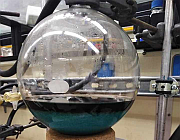Citation:
Tsoureas N, Hope RF, Haddow MF, Owen GR. Important steric effects resulting from the additional substituent at boron within scorpionate complexes containing κ3-NNH coordination modes. European Journal of Inorganic Chemistry. 2011;(34):5233 - 5241.
Abstract:
The complexes [Ru(Tai)H(PPh3)2] (4) [Tai = HB(7-azaindolyl)3] and [Ru(ArBai)H(PPh3) 2] [ArBai = Ar(H)B(7-azaindolyl)2; Ar = phenyl (5), mesityl (6) and 2-naphthyl (7)] have been prepared and fully characterised. Structural characterisation of complexes 4, 5 and 7 confirmed the expected κ3-NNH coordination mode of the azaindolyl-based ligands. In all complexes, the borohydride unit is located trans to the hydrido ligand, and the two triphenylphosphane ligands occupy sites trans to the two nitrogen donors. The strong Ru⋯H-B interaction means that the third substituent at the boron atom is held in close proximity to the ruthenium centre. In the case of complex 7, rotation of the naphthyl group about the boron centre is hindered by the triphenylphosphane substituents. The synthesis of a number of ruthenium hydride complexes containing azaindole-based scorpionate ligands is reportedherein. The scorpionate ligands bind to the metal centre with κ3-NNH coordination modes. The strong borohydride⋯metal interaction pulls the additional substituent at the boron atom towards the bulky triphenylphosphane ligands. Copyright © 2011 WILEY-VCH Verlag GmbH & Co. KGaA, Weinheim.
